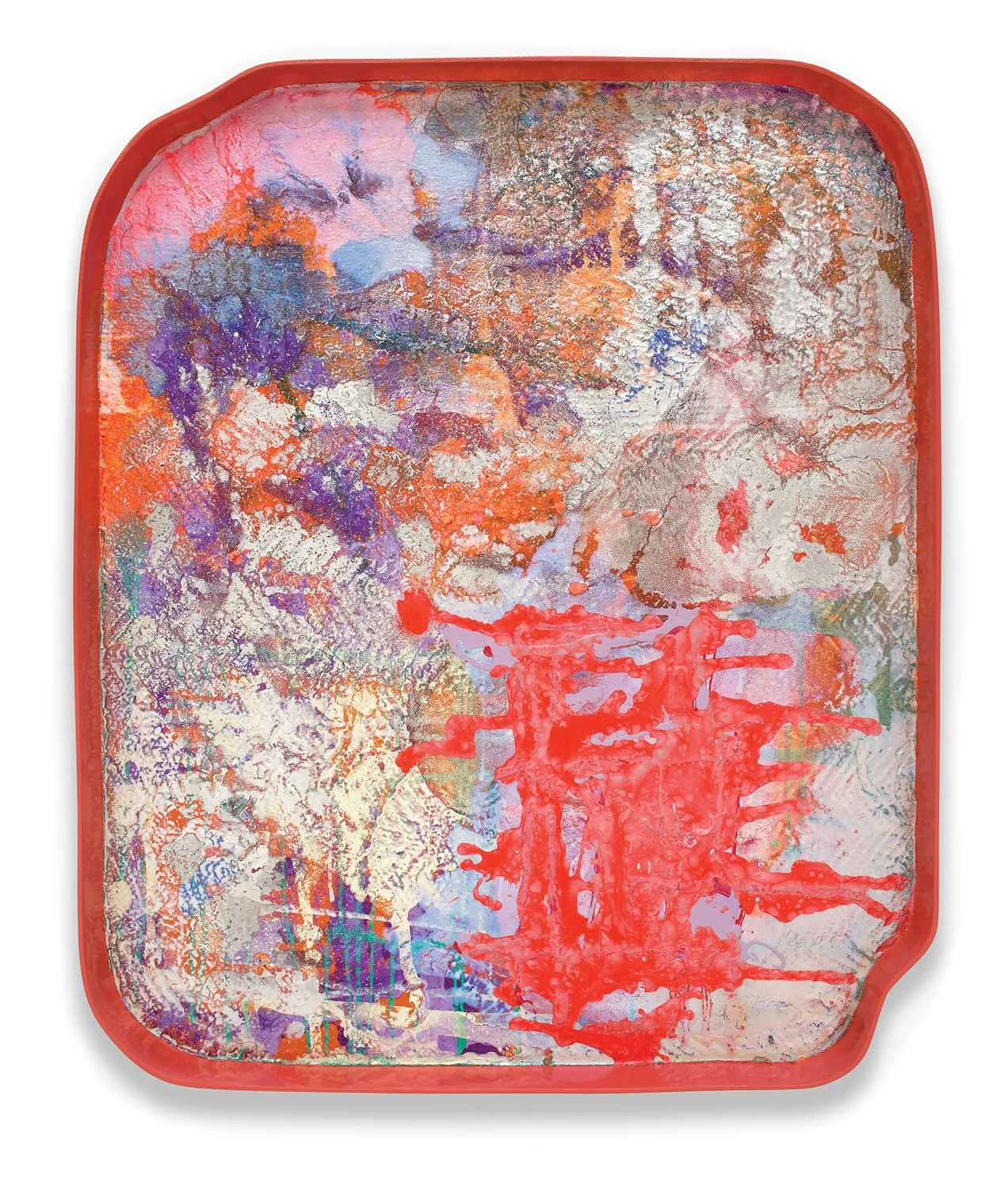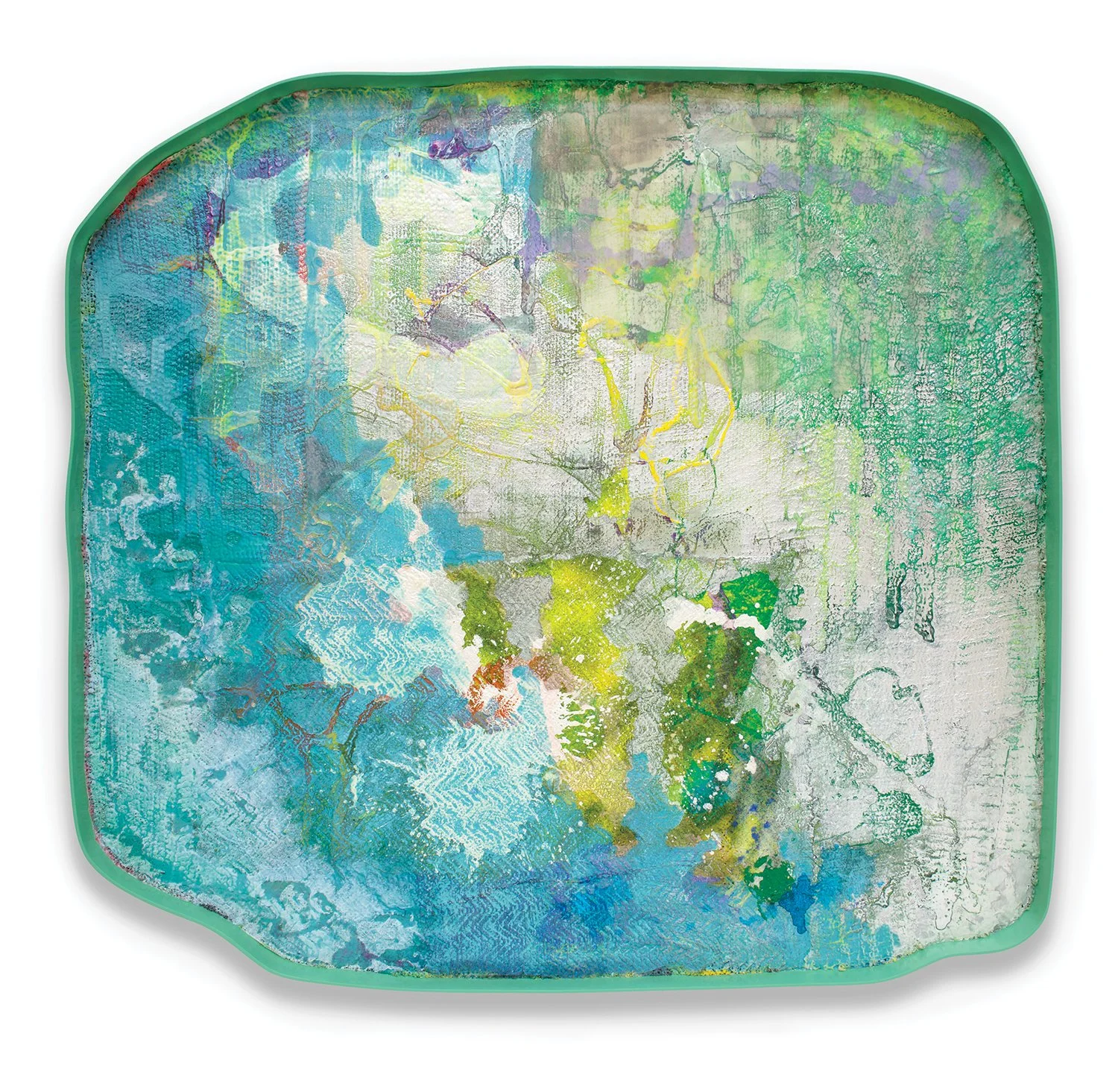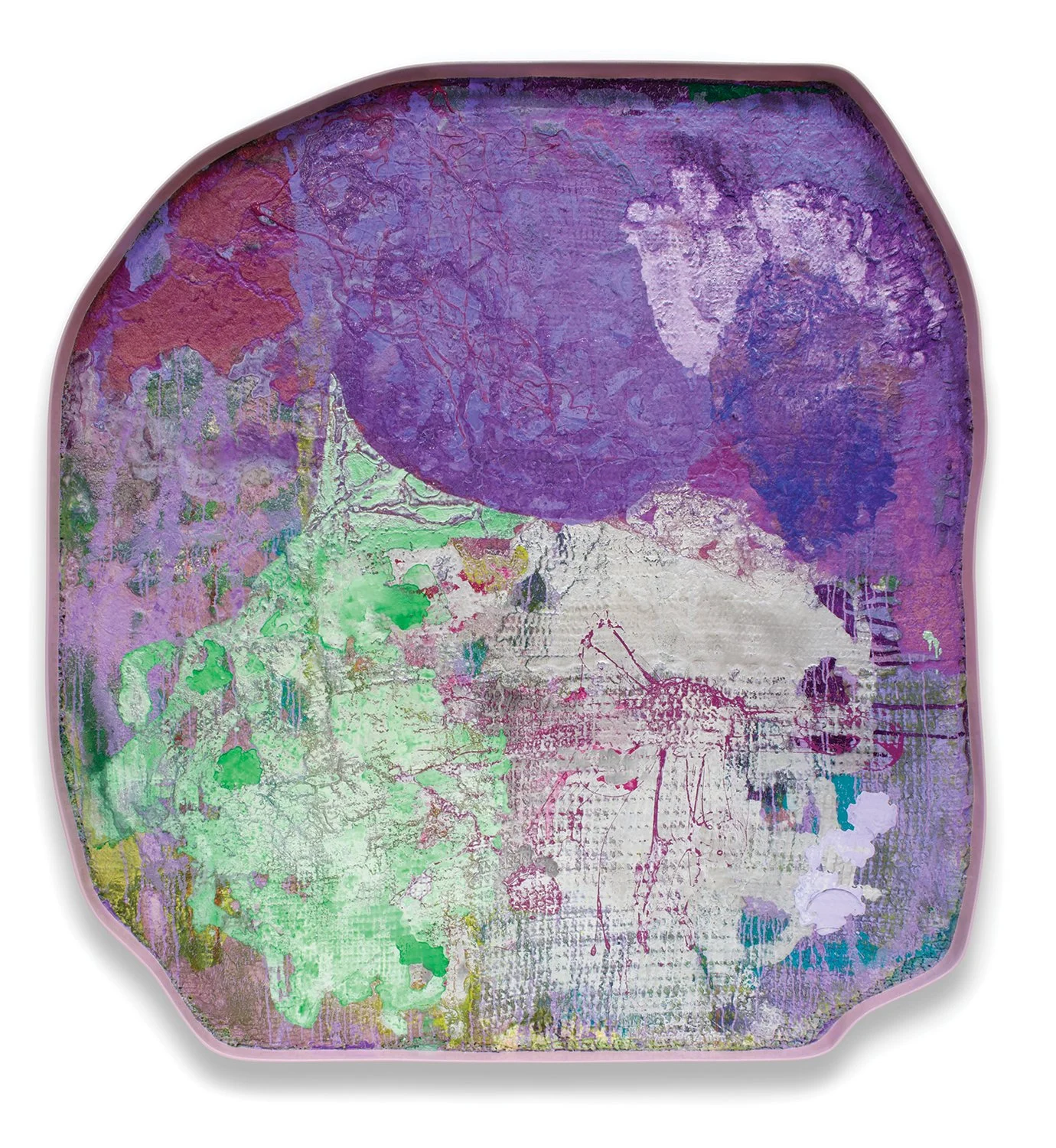THE MEDIUM IS THE MESSAGE
James Benjamin Franklin
in conversation with
Ryan Madson
James Benjamin Franklin’s work is experimental in the best sense of that oft-used expression: it deploys intentional, rigorous investigation while learning from each new result. The finished pieces suggest an artist who delights in the unexpected while discovering freedom in technique. This freedom has led Franklin to refine his practice with increasing nuance in shape, edge, color, texture, and their interactions over time. Ultimately, the artist wishes to communicate something essentially human about the making of art – the joys of creativity, as evidenced by the work itself.
“There’s an understanding of time that I appreciate,” says Franklin. “You can get a sense of how the art was made, revealing a story or history to the process – the joy, as well as the struggle. Bringing the viewer into the piece and having a shared experience about making and about life.” Creative acts are communicated and felt more urgently than aesthetics borne of intellectual preoccupations. Within a single painting, new meanings and additional layers are revealed with each viewing. Franklin’s art is evergreen, relational, and continuously inspiring.
James Benjamin Franklin (born 1972 in Tacoma, Washington) is known for his large-scale works that reimagine painting conventions using experimental materials and bold color palettes. Franklin’s paintings incorporate repurposed textiles such as blankets, towels, afghans, clothing, and bathroom mats, creating sensually-layered rafts of visual and physical texture which serve as alternative canvases.
These surfaces, in turn, are painted, poured, sprinkled, or sprayed with materials which include acrylic paint, epoxy, sand, and glitter. Whereas traditional canvas can be precious or overbearing, Franklin’s tactile surfaces are liberating and playful. They are housed in handcrafted plaster-molded frames, each with a unique geometry. Irregular shapes contain the playful chaos and complement the many-layered painting surfaces. Franklin’s process of discovery explores how specific media become more meaningful when applied to textiles and other found surfaces.
IMPACT readers might be familiar with Franklin’s work from his recent show, titled Visitor, which ran at Laney Contemporary in Savannah, Georgia during the summer of 2025. The paintings on exhibit featured vivid, saturated colors and non-objective mark-making, resulting in new finishes and atmospheres which have advanced his approach to materials. Before and after the show, James Benjamin Franklin discussed his recent paintings, inspirations, and studio practices with Ryan Madson. A series of digital correspondence captures highlights of this conversation, published here.
Portrait of James Benjamin Franklin, Photo by Tara Akitt
Ryan Madson: Where are you currently finding visual inspiration and conceptual sustenance?
James Benjamin Franklin: More and more, I think about the Southern California landscape I grew up in — varied in its textures and extreme climates. We lived at the base of the San Bernardino Mountains, with the San Andreas Fault line basically running through our backyard. There was a constant sense of impending doom, knowing the ground that you’re standing on is alive and can violently alter the land at any time.
I feel this has shaped my approach to painting. There’s an urgency and detachment to it, a need to find something meaningful to hold onto before it’s gone.
RM: Does your work make physical reference to these landscapes and precarious environments? Or are they more like affinities — a parallel set of places and memories from which you draw inspiration?
JBF: I think it’s serendipitous when the work reveals those references. The environment and landscape of San Bernardino are hard-wired into me. I don’t think about what the work is referencing while creating. Whatever comes into play is fair game. It’s only when I reach a stopping point that I begin to see the connections. My main objective when making something new is simply to create a compelling work for myself.
RM: When you were a student at the Art Center College of Design (Los Angeles) and Cranbrook Academy of Art (Michigan), what artists inspired you?
JBF: I arrived at Art Center in 1992. At the time I remember looking at Keith Haring, Sam Francis, Rufino Tamayo, Jean Dubuffet, and Richard Diebenkorn as inspiration. At Cranbrook I was looking at Paul Feely, Thornton Dial, and Shirley Jaffe, to name a few.
RM: Were you one of those artistic prodigies of whom friends and family spoke of as a “natural”? How old were you when you first started using unorthodox materials? Have you always had an affinity for process art?
JBF: Ha, nope! I think I was around 20 years old when I started exploring different materials to alter the surface. When I was first introduced to process art, I actually thought it looked lazy and kind of silly. It wasn’t until I got serious about painting that I began to develop a deeper appreciation for artists working in that language.
Hold, 2025. Acrylic, fabric, plaster, mica, and epoxy on extruded polystyrene, 41 x 40.5 x 2.75 inches. Courtesy of the artist and Laney Contemporary
RM: Do you recall what brought you to a deeper appreciation? Was there a breakthrough moment in your practice, or perhaps a recognition of a particular artist’s approach?
JBF: Paint is a substance with so many possibilities. It was a slow process building the courage to take risks by combining different mediums over time, but that all came from a curiosity to push the medium further for myself. Artists like Brice Marden, Sam Francis, and Helen Frankenthaler definitely inspired me with what can be done with paint.
Sarah Cherry (Assistant Director, Laney Contemporary): How has your daughter, Rosie, changed your practice? Is there more glitter in your life and art because of her?
JBF: More glitter for sure! I love watching her make paintings. She attacks the surface with reckless abandon, full of joy and wonder. Children are so uninhibited.
RM: When Rosie is older she will no doubt embark on creative projects which will delight and inspire you. I have a daughter (nine years old) who loves to create and make all sorts of little projects, and we collaborate often. It’s my favorite thing. Do you anticipate having her join you in the studio and creating alongside you?
JBF: Absolutely! I can’t wait to do a painting collab with her. She’ll be running the studio in no time!
RM: Your work builds upon art historical and contemporary approaches to material processes and temporal experimentation — Dubuffet, who you mentioned, comes to mind, as do Dieter Roth, Helen Frankenthaler, Frank Bowling, and the artists of Arte Povera. Meanwhile, a fearless imagination appears to be at work with your palette of vivid, saturated colors, lush textures, and the complex interplay between textiles, paints, pigments, and additives of non-traditional media.
Call, 2025. Acrylic, fabric, plaster, mica, and epoxy on extruded polystyrene, 67.25 x 72.75 x 3.25 inches. Courtesy of the artist and Laney Contemporary
Without revealing too much of the magical formulae that go into your studio alchemy, I’d love to hear more about certain aspects of your process. How do you collect the textiles that become your “canvases”? Did some of these materials have a previous life?
JBF: The materials I use have changed over the years. I’m constantly shifting, gravitating toward different thicknesses and textile patterns that interest me. I’m definitely more specific about the type of blanket I use than I was even a year ago. Most of them, I imagine, had a previous life in a domestic setting, though a few show minimal signs of use.
The colors and patterns in the blankets become, in a way, the architecture of the painting at the beginning. Their placement is very deliberate when they are glued down. The patterns dictate how the paint moves across the surface, depending on how much of it has been built up with medium. The colors in the textile serve as a reference, something to respond to.
RM: Do you have any favorite thrift stores where you gather your textiles?
JBF: I usually pick them up at a thrift store called Value World. They have several locations around the Detroit area.
RM: Do textiles with more personal histories make it into the work?
JBF: Some items from home, like discarded towels or washcloths, make it in. Mostly, it’s items from secondhand stores. There’s an inherent domestic history in those textiles — such a different feel compared to buying them from a big-box store.
RM: Experimentation in your practice comes much closer to the meaning of the concept, which involves rigorous trial-and-error followed by informed consideration and comparison of the results. How does your practice physically unfold in the studio as you apply media to textiles? For example, do your handmade frames become “trays” which rest horizontally in the studio as you apply media?
JBF: Yes, they’re giant trays. I would say about 95% of the image-making happens on the floor. During the day, they lean against the wall while I figure out what to do next. It usually takes several hours for any medium or paint to dry, so I apply it before leaving for the day and let it dry overnight.
Wait, 2025. Acrylic, fabric, plaster, mica, and epoxy on extruded polystyrene, 43 x 36 x 2.75 inches. Courtesy of the artist and Laney Contemporary
RM: How do the angle and direction of the lean influence the outcomes? Is this something that you control as the medium dries?
JBF: It only influences the paint to a point — the direction and pooling of the colors are also dictated by the surface disruptions. I do have some control, but there’s a lot of shimming involved to get the paint to settle the way I want, especially in a specific area.
RM: Your practice is partly about advancing your own language of discovery. On several occasions you described to me your enjoyment of procedural mark-making, of taking delight in continuously surprising yourself with the results. Your new series features weird and wonderful evolutions of this language. Audiences already familiar with your work will make new discoveries about your mark-making and layering of surfaces.
I’m left gobsmacked in the presence of your recent work, asking questions like: “How did that shiny bit get under there? Which of these areas of color or lacquer dried first? How was the frame positioned when the media were applied?” Bringing a curious viewer along with you on this experimental — and experiential — journey lies at the heart of your art. Do you have such communication with your audiences in mind as you create?
JBF: I do think of the viewer, though really only after the work is completed. I can only control what happens in the studio. Once the work leaves, it takes on a life of its own. I know what I like to see and experience in a painting, so I try to push each piece as far as I can, and I hope the viewer also finds it engaging.
RM: Indeed. I know that so many of us do!
Visual inspiration and self promotion are more abundant than ever on digital platforms, yet you have admirably resisted the call of Instagram et al. Do you have a position as an artist regarding social media? Perhaps your website, combined with publicity in more traditional art media — online and print, such as a recent review in Art Forum — provides an amount of exposure that you are comfortable with?
Seek, 2024. Acrylic, fabric, plaster, mica, and epoxy on extruded polystyrene, 69 x 66 x 3.5 inches. Courtesy of the artist and Laney Contemporary
JBF: I wanted to take a break from Instagram, so for my 2020 New Year's resolution I deactivated my account. And I haven’t turned it back on since. I’m a huge procrastinator and easily distracted, so Instagram wasn’t helping at all. I do feel I need some kind of presence online. I like to exhibit my work, so my website fills that void. But I don’t need to maintain it daily or get thrown off by a comment or a likability score. I really want to avoid unnecessary noise.
That said, Instagram is a powerful tool for artists. If you want to exhibit or share your work, there’s no faster way to get it out there — especially if you don’t live in one of the big art markets!
SC: I always find myself looking to titles, not necessarily for direction but as another layer to the work, or as an external presence, perhaps. Can you tell us a little about the names for this new body of work? Were they chosen before or after creation?
JBF: The titles are chosen 99% of the time after the work is completed. Occasionally, a title comes to me while I’m creating a piece, but that’s rare. I want the title to be a poetic welcome mat into the work. I like them to complement the piece in an open-ended way. Making the work is such a journey. It feels necessary to give them a name, like a ship!
RM: I first experienced one of your paintings in person at the Google Ventures office in Manhattan, where Susan Laney, founder and director of Laney Contemporary, facilitated the acquisition of their collection. Later, I had the good fortune to visit your solo show at Proyectos Monclova in Mexico City. I was delighted to have discovered a new favorite artist! That encounter with so many of your dazzling works in one place inspired us — especially the experience of the work changing around us, and with us, as we moved through the gallery spaces. For Susan, her admiration for your work began with an earlier encounter at Reyes Finn Gallery at the Independent Art Fair in New York. Together, these experiences set in motion the show at Laney Contemporary, as well as your recent showing at Untitled Art in Miami last December.
What does it mean for you personally to have a show here in Savannah? How does the title of the show, Visitor, reflect these contexts?
JBF: Thank you! This will be my very first visit to Savannah. Everyone always tells me how beautiful it is. I’ve known about the Savannah College of Art and Design since I first started looking at art schools long ago. I'm just excited to finally explore and experience the place in person. I'm so happy Susan extended the invitation!
The title brings to mind a sense of optimism, temporality, otherworldliness, and discovery. I thought it was a perfect fit for the exhibition.
RM: As a follow-up, many of these questions were asked prior to the installation of your work at Laney Contemporary. Now that you’ve visited Savannah, do you have any takeaways from the show or lasting impressions of Savannah?
JBF: You and Susan are the best hosts! I had an incredible time in Savannah. I’ve never seen so many town squares in my life! Savannah is hauntingly beautiful at night with all those majestic live oaks. I was so happy to finally see the SCAD Museum of Art. Best drinks at Lone Wolf and Savoy Society!
It was amazing to experience the natural light in person at Laney Contemporary — I saw things in my work I’d never noticed before. They were radiant!
See more of James Benjamin Franklin’s work this year with Broadway at Art Basel Miami Beach, 2025. Coming up at Laney Contemporary: Tori Tinsley: Sad Rider opens October 3 and will be on view through January 10, 2026
###










